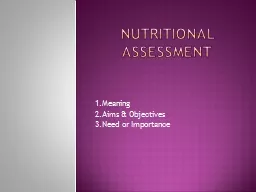

2Aims amp Objectives 3Need or Importance Nutrtional status It is the condition of health of an individual as influenced by the intake and utilisation of the nutrients determined from the physical biochemical and dietary studies ID: 912922
Download Presentation The PPT/PDF document "Nutritional aSSessMent 1.Meaning" is the property of its rightful owner. Permission is granted to download and print the materials on this web site for personal, non-commercial use only, and to display it on your personal computer provided you do not modify the materials and that you retain all copyright notices contained in the materials. By downloading content from our website, you accept the terms of this agreement.
Slide1
Nutritional aSSessMent
1.Meaning
2.Aims & Objectives
3.Need or Importance
Slide2Nutrtional status
It is the condition of health of an individual as influenced by the intake and
utilisation
of the nutrients determined from the physical, biochemical and dietary studies
Nutritional status may be either good or poor.
Good nutritional status refers to intake of a well-balanced diet which supplies all essential nutrients to meet the body’s requirements.
Slide3Assessment of nutritional status
The nutritional assessment is a systematic process in which the state of nutrition and health of individual or group of individuals is determined.
Aims & Objectives
To map out the magnitude and geographical distribution of malnutrition as a public health problem.
To discover and analyze the ecological factors that are directly or indirectly responsible.
Slide4Aims and Objectives
3. To suggest appropriate corrective measures to control and eradicate malnutrition.
4. To determine the type of malnutrition.
5. To identify the at –risk groups.
Methods
Direct assessment
Anthropometry
Clinical examination
Biochemical estimation
Indirect assessment
Diet survey
Vital health statistics
Slide5anthropometry
Tool concerned with the measurement of the variations of the physical dimensions, and the gross composition of the human body at different age levels and degrees of nutrition.
Common anthropometric measurements
Body weight
: mostly used and the simplest reproducible anthropometric measurement.
Equipment
: Salter weighing scale(beam balance) for toddler.
Digital/simple weighing scale for adults.
Slide6Height
: Very reliable parameter that reflects the total increase in size of individual.
Equipment
: a vertical measuring rod or a scale fixed to a wall for older children and adults i.e.,
Anthropometer
rods or
Stadiometer
scales.
Infantometer
for infant and preschool children.
Head circumference
: Head circumference is related to mainly size of brain.
Equipment:
flexible non stretchable fibre glass tape.
Slide7Anthropometry
Chest circumference:
The chest in normally nourished child grows faster than head during the second and third year of life.
Equipment:
narrow flexible non-stretchable fibre glass tape.
Mid-upper arm circumference (MUAC):
It indicates the status of muscle development.
Equipment:
non-stretchable flexible fibre glass tape, 3-colour tape (
shakir’s
tape
)
Slide8Subcutaneous body fat measurement:
Adipose tissue is widely distributed over a large number of sites in the body.
Equipment:
Harpenden
calipers, Lange calipers and the USA-MRNL calipers.
Advantages:
Simplicity
Help in the assessment of sub clinical forms of malnutrition.
Reliable tool to identify ‘at-risk’ groups.
Monitoring changes in extent of malnutrition.
Slide9Limitations of anthropometry
Results may not be accurate if the instruments used are not calibrated properly.
Results obtained should be compared with other assessment to get final results.
Reference standard should be revised constantly.
Slide10Assessment of adults
Body Mass Index (BMI): weight in kg/Ht
2
in m
Waist and Hip ratio
Brocca’s
index: Ht in cm-100= ideal body weight
.
Slide11biochemical
More objective, precise and sensitive methods for evaluation of nutritional status.
Aid in diagnosis of primary malnutrition.
Valuable in guiding to take necessary actions in secondary malnutrition
For example, serum protein i.e., serum albumin level, level of the blood forming nutrients as iron,
folacin
,
vit
B
6
and
vit
B
12
, level of blood lipids as cholesterol and triglycerides, glucose and various enzymes.
Slide12biochemical
Advantages:
Sensitive
Specific
Easy to carry out
Limitations
Time consuming
Expensive
Cannot be applied for large group
Experienced and well-trained expertise are needed
Slide13Clinical assessment
Physical signs and symptoms of malnutrition can be valuable aids in detecting nutritional deficiencies.
WHO committee on Medical Assessment of Nutritional Status ( 1962 and 1966) has classified the physical signs associated with malnutrition into 3-groups as
Group I: signs that are considered to be of value in nutritional assessment.
Group II: signs that need further investigation.
Slide14Clinical assessment
Group III: physical signs that have no relation to malnutrition.
Advantages:
Inexpensive
Simplest and most practical method
Valuable and objective information to public health workers.
Limitations
Gives false positive results
Proper training of personnel
Slide15Indirect assessment
Diet Survey
Vital part in determining the health and nutritional status of people.
Indicates relative dietary inadequacy or excess, helpful in planning health education
programme
.
Methods of diet survey:
Weighment
method
24-hour recall method (oral questionnaire method)
Diet history method
Food intake record/food diary method
Slide16Indirect assessment
Expenditure pattern method/ written questionnaire
Food inventory method
Food frequency check list
Chemical analysis/ duplicate sample method
Dietary score
Vital statistics
Important data or numerical information concerning the vital events of human life as, birth, illness, death etc. within
a population.